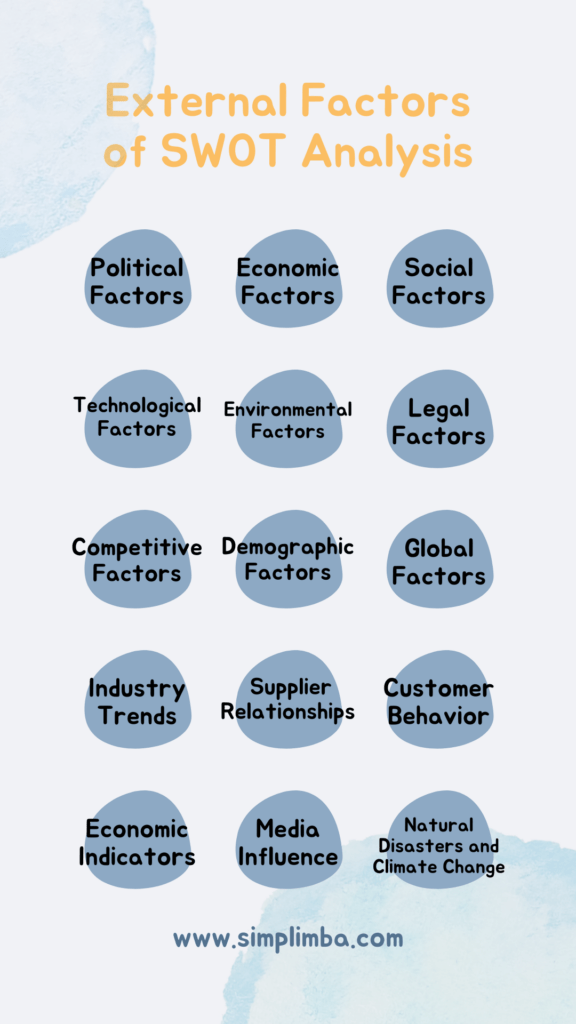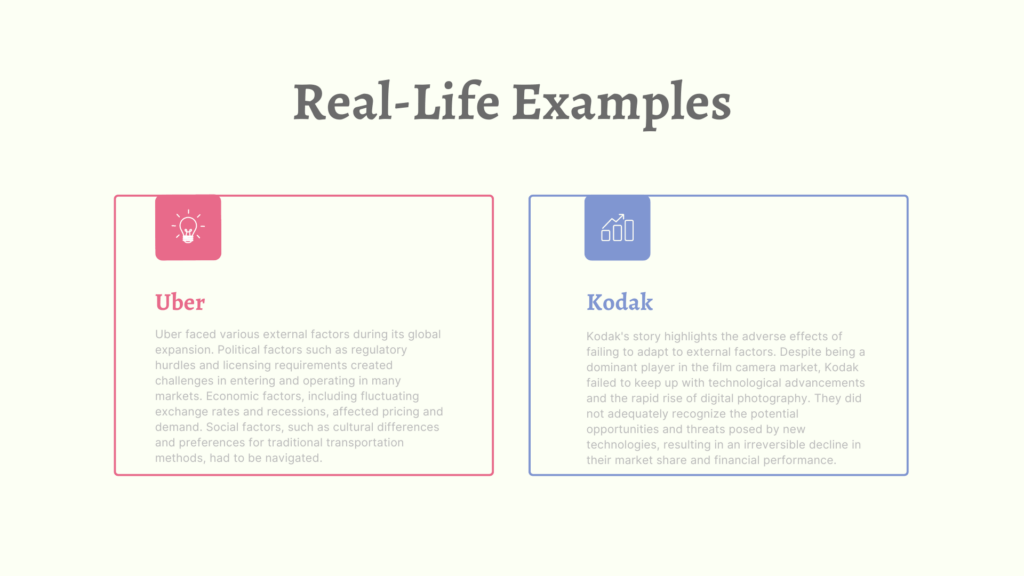Introduction
SWOT (Strengths, Weaknesses, Opportunities, Threats) analysis is a strategic framework widely used by businesses and organizations worldwide. It helps in assessing an entity’s internal strengths and weaknesses, as well as external opportunities and threats. While the internal factors are within the control of the organization, the external factors, which we will focus on in this blog, refer to the forces beyond the firm’s immediate influence. Understanding these external factors is crucial for successful decision-making and effective strategic planning.
External Factors of SWOT Analysis
We have broken down the post into 15 comprehensive factors that impact your SWOT analysis. Remember, while it’s important to consider a wide range of external factors, not all factors will be equally relevant to every business or industry. The key is to identify and prioritize the most critical external factors that directly impact your organization’s strategic decision-making and long-term success.

1. Political Factors:
Political factors strongly impact business operations and strategies. Government policies, regulations, stability, and the legal framework influence market entry, taxation, political stability, and the overall business environment. For instance, changes in tax policies or tariffs can significantly affect a company’s profitability or product pricing strategy.
2. Economic Factors:
Economic factors encompass macroeconomic indicators, including GDP growth rates, inflation, interest rates, exchange rates, and unemployment. These factors influence consumer behavior, purchasing power, investment decisions, market demand, and the overall economic landscape. A strong economy can create growth opportunities, while economic downturns may present challenges.
3. Social Factors:
Social factors involve cultural, demographic, and lifestyle aspects of a population. They impact consumer preferences, trends, and behavior. Socio-cultural shifts, such as changing values, attitudes, and social norms, greatly influence market demand and consumer choices. For instance, a growing trend towards healthy lifestyles may lead to increased demand for organic food products.
4. Technological Factors:
Technological factors relate to advancements and innovations within the industry, as well as changes in information technology, digitalization, automation, and infrastructure. Technological developments can disrupt existing business models, create opportunities for new market entrants, and enable productivity enhancements through enhanced operational efficiency.
5. Environmental Factors:
Environmental factors encompass the physical, ecological, and sustainability aspects surrounding a business. With increasing global concerns over climate change, resource depletion, and environmental conservation, firms have to adapt to stricter regulations and consumer demands for eco-friendly products and practices. Understanding these factors can help a business position itself as a responsible and sustainable player in the market.
6. Legal Factors:
Legal factors refer to the laws, regulations, and legal constraints that affect business operations. Legislation related to competition, labor, intellectual property, health and safety, and consumer protection significantly impact industry dynamics. Noncompliance with legal requirements can lead to severe penalties or damage a company’s reputation.
7. Competitive Factors:
Analyzing external factors necessitates examining the competitive landscape. Identifying current and potential competitors, market dynamics, and industry trends is crucial. Competition intensity, market share, customer loyalty, and pricing structures are essential aspects to consider while conducting a SWOT analysis.
8. Demographic Factors:
Demographic factors include characteristics such as age, gender, ethnicity, and income levels of the target market. These factors influence consumer behavior and preferences, product demand, and marketing strategies. For instance, an aging population may create opportunities for businesses offering products and services tailored to the needs of elderly individuals.
9. Global Factors:
Global factors refer to international trends, geopolitical situations, and global market dynamics. Globalization has expanded business opportunities but also increased competition from international players. Global factors influence market access, trade agreements, exchange rates, and cultural diversities, which can significantly impact a company’s strategies and operations.
10. Industry Trends:
Analyzing industry-specific trends is crucial to understanding external factors. Stay updated on technological advancements, emerging markets, consumer preferences, and shifts in competitive dynamics within your industry. Recognizing these trends allows businesses to identify opportunities and adjust their strategies accordingly.
11. Supplier Relationships:
The relationships with suppliers and their capabilities can significantly impact a company’s performance. Supplier factors such as reliability, quality, pricing, and flexibility can influence production processes, costs, and the ability to meet customer demands. Identifying potential risks related to suppliers is essential to ensure consistent supply chain management.
12. Customer Behavior:
Understanding customer behavior and preferences is paramount to business success. Factors like customer loyalty, buying patterns, and preferences can impact marketing and product strategies, pricing, and brand positioning. Conducting market research and gathering customer feedback can provide valuable insights into these external factors.
13. Economic Indicators:
Beyond the general economic factors mentioned earlier, specific economic indicators within the industry should be considered. For example, in the housing industry, factors like interest rates, mortgage rates, and housing affordability greatly affect the demand for housing and related services.
14. Media Influence:
The media can have a significant impact on the public perception of a company or industry. Positive or negative media coverage, social media trends, and influencer marketing can shape consumer attitudes, brand reputation, and market perception. Monitoring and managing media influence is crucial in today’s connected world.
15. Natural Disasters and Climate Change:
Natural disasters and climate change pose external risks to businesses, particularly those operating in vulnerable regions or industries. These factors can disrupt supply chains, damage physical infrastructure, and impact customer demand. Understanding and mitigating the potential risks associated with natural disasters and climate change is essential for business resilience.
Real-Life Examples:
To illustrate the significance of external factors in SWOT analysis, let’s consider two companies: Uber and Kodak.

Uber:
Uber faced various external factors during its global expansion. Political factors such as regulatory hurdles and licensing requirements created challenges in entering and operating in many markets. Economic factors, including fluctuating exchange rates and recessions, affected pricing and demand. Social factors, such as cultural differences and preferences for traditional transportation methods, had to be navigated. Technological factors played a significant role, as Uber had to adapt to evolving user preferences and emerging technologies like self-driving cars. Legal factors, such as lawsuits and disputes over drivers’ employment classifications, also shaped the business environment.
Kodak:
Kodak’s story highlights the adverse effects of failing to adapt to external factors. Despite being a dominant player in the film camera market, Kodak failed to keep up with technological advancements and the rapid rise of digital photography. They did not adequately recognize the potential opportunities and threats posed by new technologies, resulting in an irreversible decline in their market share and financial performance.
Conclusion:
Understanding the external factors of SWOT analysis is crucial for businesses to navigate their competitive landscape, exploit opportunities, and mitigate threats effectively. By analyzing and integrating various external factors into their strategic decision-making process, organizations can adapt to changing environments, drive innovation, and sustain long-term success. Remember, a thorough examination of the external factors will bring depth and valuable insights to your SWOT analysis, leading to informed decisions and robust strategic planning
Samrat is a Delhi-based MBA from the Indian Institute of Management. He is a Strategy, AI, and Marketing Enthusiast and passionately writes about core and emerging topics in Management studies. Reach out to his LinkedIn for a discussion or follow his Quora Page

